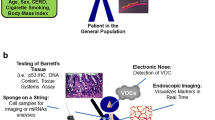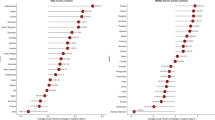Abstract
Background
Barrett’s esophagus is the precursor to the highly lethal esophageal adenocarcinoma. Risk prediction models have been developed to assist in its detection, potentially improving early identification and treatment of esophageal adenocarcinoma. Six models have been developed.
Aims
To externally validate three models (Rubenstein, Thrift, and Baldwin-Hunter models) and compare them to a fourth risk prediction model (Ireland model) for Barrett’s esophagus.
Methods
Data from 120 Barrett’s cases and 235 population controls were available to externally validate the three models. Discriminatory ability of these models was assessed by the area under the receiver operating characteristic curve. Calibration was assessed with the calibration slope, Hosmer–Lemeshow test, and Lowess smoother calibration plot. Following external validation, diagnostic accuracy of the three models was compared to that of the Ireland model.
Results
On external validation, the Rubenstein model had an area under the receiver operating characteristic curve of 0.71 and was well calibrated (Hosmer–Lemeshow test, p = 0.67). Likewise, the Thrift and Baldwin-Hunter models had similar discrimination (0.71 and 0.70, respectively) and were also well calibrated (p = 0.69 and p = 0.28). Our previous external validation of the Ireland model provided an area under the receiver operating characteristic curve of 0.83 and was well calibrated (p = 0.14). The Ireland model demonstrated a statistically significantly greater area under the receiver operating characteristic curve than the Rubenstein (p = 0.02), Thrift (p = 0.001), and Baldwin-Hunter (p = 0.002) models.
Conclusion
We externally validated the Rubenstein, Thrift, and Baldwin-Hunter risk prediction models and compared them to the Ireland model. The Ireland model demonstrated improved accuracy, albeit with slightly poorer calibration.


Similar content being viewed by others
References
Moinova HR, LaFramboise T, Lutterbaugh JD, et al. Identifying DNA methylation biomarkers for non-endoscopic detection of Barrett’s esophagus. Sci Transl Med. 2018;10:1–11.
Appelman HD, Umar A, Orlando RC, et al. Barrett’s esophagus: natural history. Ann NY Acad Sci. 2011;1232:292–308.
Sanghi V, Thota PN. Barrett’s esophagus: novel strategies for screening and surveillance. Ther Adv Chronic Dis. 2019;10:1–14.
Qumseya B, Sultan S, Bain P, et al. ASGE guideline on screening and surveillance of Barrett’s esophagus. Gastrointest Endosc. 2019;90:335–359.
Ronkainen J, Aro P, Storskrubb T, et al. Prevalence of Barrett’s esophagus in the general population: an endoscopic study. Gastroenterology. 2005;129:1825–1831.
Lim YC, Fitzgerald RC. Diagnosis and treatment of Barrett’s oesophagus. Br Med Bull. 2013;107:117–132.
Whiteman DC, Appleyard M, Bahin FF, et al. Australian clinical practice guidelines for the diagnosis and management of Barrett’s esophagus and early esophageal adenocarcinoma. J Gastroenterol Hepatol. 2015;30:804–820.
Fitzgerald RC, di Pietro M, Ragunath K, et al. British Society of Gastroenterology guidelines on the diagnosis and management of Barrett’s oesophagus. Gut. 2014;63:7–42.
Shaheen NJ, Falk GW, Iyer PG, Gerson LB. ACG clinical guideline: diagnosis and management of Barrett’s esophagus. Am J Gastroenterol. 2016;111:30–50.
Locke GR, Zinsmeister AR, Talley NJ. Can symptoms predict endoscopic findings in GERD? Gastrointest Endosc. 2003;58:661–670.
Gerson LB, Edson R, Lavori PW, Triadafilopoulos G. Use of a simple symptom questionnaire to predict Barrett’s esophagus in patients with symptoms of gastroesophageal reflux. Am J Gastroenterol. 2001;96:2005–2012.
Rubenstein JH, Morgenstern H, Appelman H, et al. Prediction of Barrett’s esophagus among men. Am J Gastroenterol. 2013;108:353–362.
Thrift AP, Kendall BJ, Pandeya N, Vaughan TL, Whiteman DC. A clinical risk prediction model for Barrett esophagus. Cancer Prev Res. 2012;5:1115–1123.
Liu X, Wong A, Kadri SR, et al. Gastro-esophageal reflux disease symptoms and demographic factors as a pre-screening tool for Barrett’s esophagus. PLoS ONE. 2014;9:1–8.
Ireland CJ, Fielder AL, Thompson SK, Laws TA, Watson DI, Esterman A. Development of a risk prediction model for Barrett’s esophagus in an Australian population. Dis Esophagus. 2017;30:1–8.
Baldwin-Hunter BL, Knotts RM, Leeds SD, Rubenstein JH, Lightdale CJ, Abrams JA. Use of the electronic health record to target patients for non-endoscopic Barrett’s esophagus screening. Dig Dis Sci. 2019;64:3463–3470. https://doi.org/10.1007/s10620-019-05707-2.
Thrift AP, Kanwal F, El-Serag HB. Prediction models for gastrointestinal and liver diseases: too many developed, too few validated. Clin Gastroenterol Hepatol. 2016;14:1678–1680.
Rubenstein JH, Thrift AP. Risk factors and populations at risk: selection of patients for screening for Barrett’s oesophagus. Best Pract Res Clin Gastroenterol. 2015;29:41–50.
Ireland CJ, Gordon AL, Thompson SK, et al. Validation of a risk prediction model for Barrett’s esophagus in an Australian population. Clin Exp Gastroenterol. 2018;11:135–142.
Greiner M, Pfeiffer D, Smith RD. Principles and practical application of the receiver-operating characteristic analysis for diagnostic tests. Prev Vet Med. 2000;45:23–41.
DeLong ER, DeLong DM, Clarke-Pearson DL. Comparing the areas under two or more correlated receiver operating characteristic curves: a nonparametric approach. Biometrics. 1988;44:837–845.
Steyerberg EW, Vickers AJ, Cook NR, et al. Assessing the performance of prediction models: a framework for traditional and novel measures. Epidemiology. 2010;21:128–138.
Fluss R, Faraggi D, Reiser B. Estimation of the Youden Index and its associated cutoff point. Biom J. 2005;47:458–472.
Zimmerman TG. Common questions about Barrett esophagus. Am Fam Physician. 2014;89:92–98.
Buttner P, Muller R. Epidemiology. 1st ed. Oxford: Oxford University Press; 2011.
De Jonge PJF, Van Blankenstein M, Grady WM, Kuipers EJ. Barrett’s oesophagus: epidemiology, cancer risk and implications for management. Gut. 2014;63:191–202.
Fass R, Sampliner RE. Barrett’s oesophagus: optimal strategies for prevention and treatment. Drugs. 2003;63:555–564.
Thrift AP, Whiteman DC. The incidence of esophageal adenocarcinoma continues to rise: analysis of period and birth cohort effects on recent trends. Ann Oncol. 2012;23:3155–3162.
Schoofs N, Bisschops R, Prenen H. Progression of Barrett’s esophagus toward esophageal adenocarcinoma: an overview. Ann Gastroenterol. 2017;30:1–6.
El-Serag HB, Naik AD, Duan Z, et al. Surveillance endoscopy is associated with improved outcomes of oesophageal adenocarcinoma detected in patients with Barrett’s oesophagus. Gut. 2016;65:1252–1260.
Thrift AP, Vaughan TL, Anderson LA, Whiteman DC, El-Serag HB. External validation of the michigan Barrett esophagus prediction tool. Clin Gastroenterol Hepatol. 2017;15:1124–1126.
Dong J, Buas MF, Gharahkhani P, et al. Determining risk of Barrett’s esophagus and esophageal adenocarcinoma based on epidemiologic factors and genetic variants. Gastroenterology. 2018;154:1273–1281.
Kunzmann AT, Canadas Garre M, Thrift AP, et al. Information on genetic variants does not increase identification of individuals at risk of esophageal adenocarcinoma compared to clinical risk factors. Gastroenterology. 2019;156:43–45.
Thrift AP, Garcia JM, El-Serag HB. A multibiomarker risk score helps predict risk for Barrett’s esophagus. Clin Gastroenterol Hepatol. 2014;12:1267–1271.
Vaughan TL, Fitzgerald RC. Precision prevention of oesophageal adenocarcinoma. Nat Rev Gastroenterol Hepatol. 2015;12:243–248.
Freeman M, Offman J, Walter FM, Sasieni P, Smith SG. Acceptability of the Cytosponge procedure for detecting Barrett’s oesophagus: a qualitative study. BMJ Open. 2017;7:e013901.
Thrift AP, Kramer JR, Richardson PA, El-Serag HB. No significant effects of smoking or alcohol consumption on risk of Barrett’s esophagus. Dig Dis Sci. 2014;59:108–116. https://doi.org/10.1007/s10620-013-2892-6
Akiyama T, Inamori M, Iida H, et al. Alcohol consumption is associated with an increased risk of erosive esophagitis and Barrett’s epithelium in Japanese men. BMC Gastroenterol. 2008;8:1–6.
Veugelers PJ, Porter GA, Guernsey DL, Casson AG. Obesity and lifestyle risk factors for gastroesophageal reflux disease, Barrett esophagus and esophageal adenocarcinoma. Dis Esophagus. 2006;19:321–328.
Ireland CJ, Thompson SK, Laws TA, Esterman A. Risk factors for Barrett’s esophagus: a scoping review. Cancer Cause Control. 2016;27:301–323.
Author information
Authors and Affiliations
Corresponding author
Ethics declarations
Conflict of interest
The authors declare that they have no conflict of interest.
Additional information
Publisher's Note
Springer Nature remains neutral with regard to jurisdictional claims in published maps and institutional affiliations.
Rights and permissions
About this article
Cite this article
Ireland, C.J., Thrift, A.P. & Esterman, A. Risk Prediction Models for Barrett’s Esophagus Discriminate Well and Are Generalizable in an External Validation Study. Dig Dis Sci 65, 2992–2999 (2020). https://doi.org/10.1007/s10620-019-06018-2
Received:
Accepted:
Published:
Issue Date:
DOI: https://doi.org/10.1007/s10620-019-06018-2




